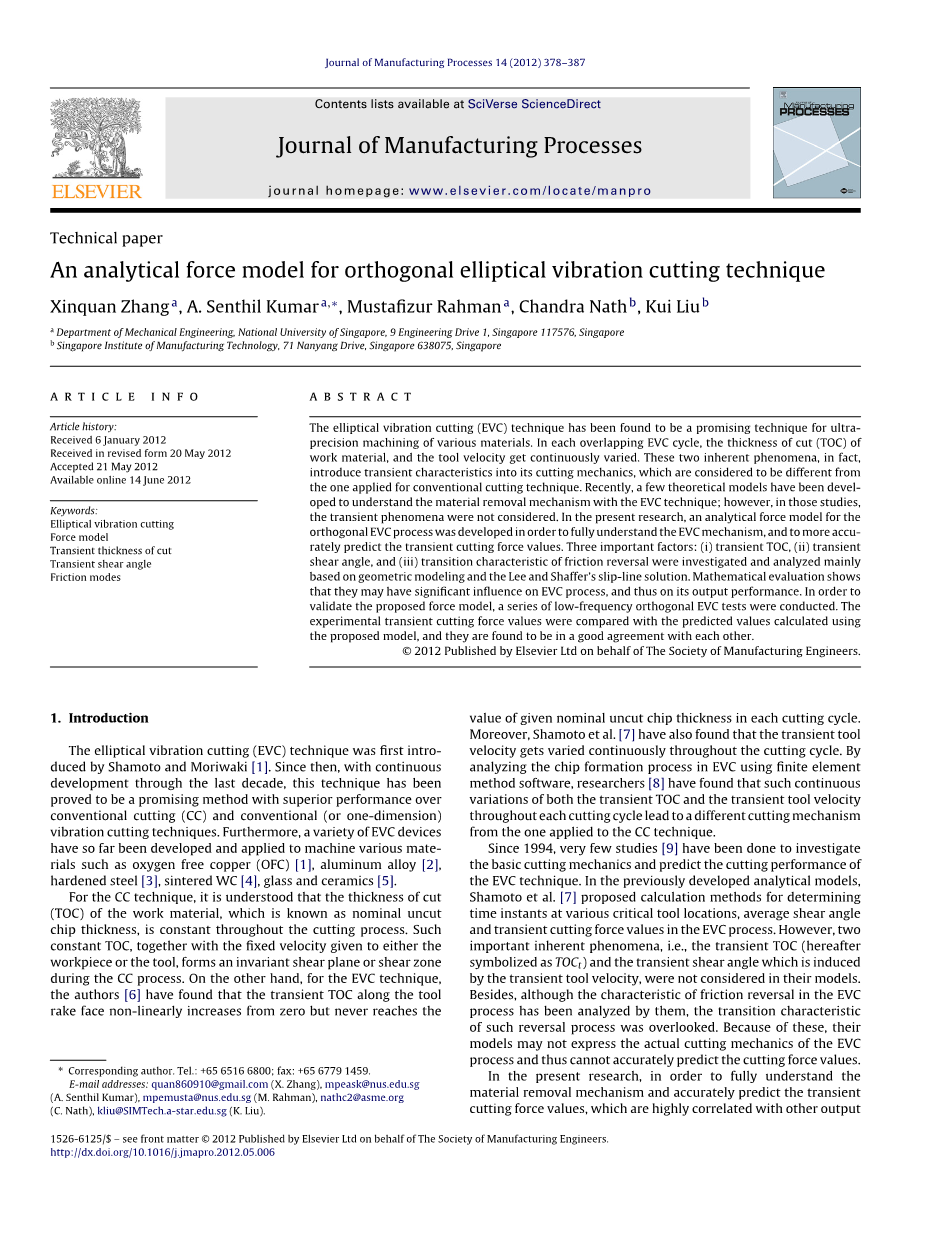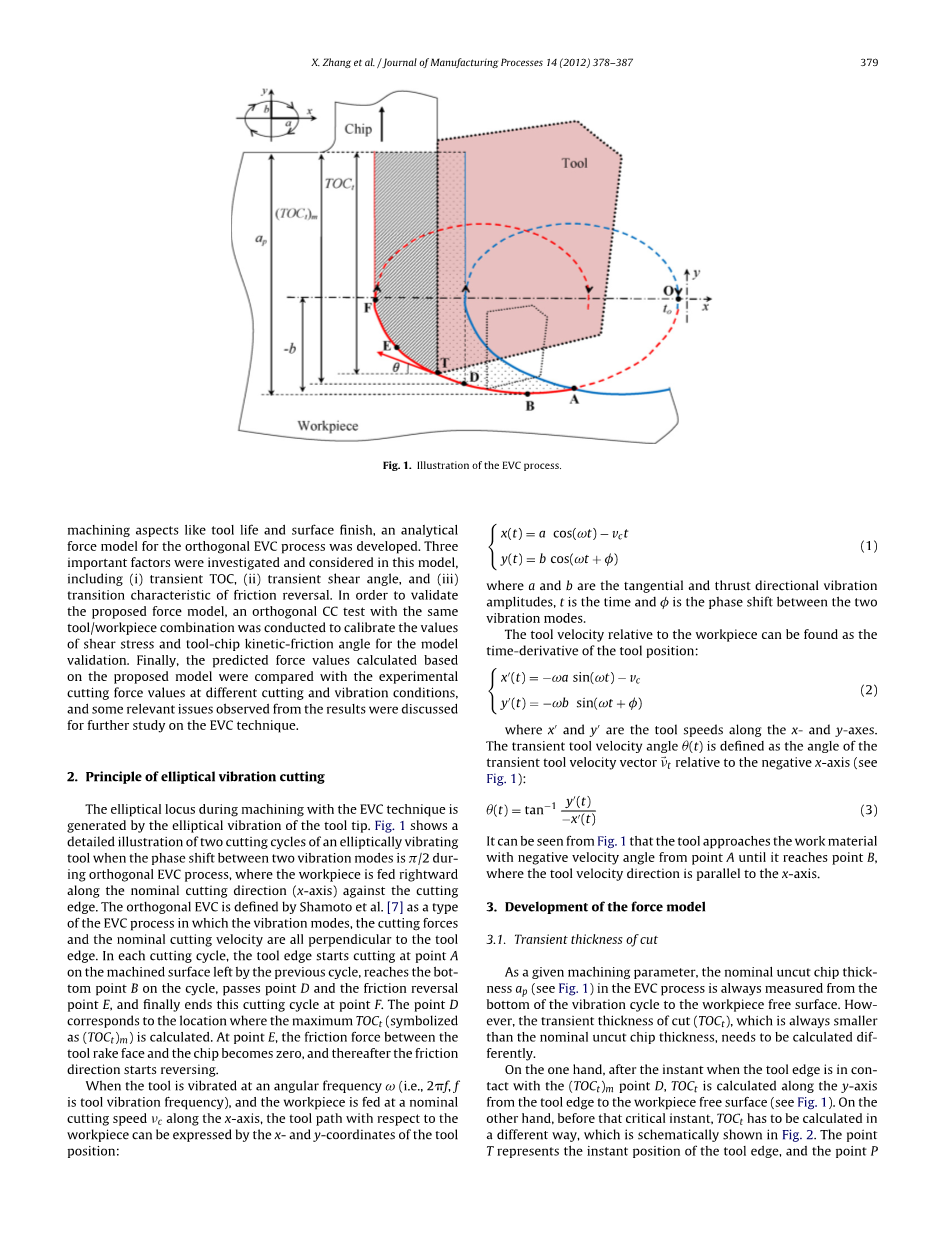

英语原文共 10 页,剩余内容已隐藏,支付完成后下载完整资料
An analytical force model for orthogonal elliptical vibration cutting technique
Xinquan Zhang a , A. Senthil Kumar a,lowast; ,
Mustafizur Rahman a , Chandra Nath b , Kui Liu b
Received:6 January 2012/Received in revised form 20 May 2012
Accepted:21 May 2012/Available online :14 June 2012
Abstract
The elliptical vibration cutting (EVC) technique has been found to be a promising technique for ultraprecision machining of various materials. In each overlapping EVC cycle, the thickness of cut (TOC) of work material, and the tool velocity get continuously varied. These two inherent phenomena, in fact, introduce transient characteristics into its cutting mechanics, which are considered to be different from the one applied for conventional cutting technique. Recently, a few theoretical models have been developed to understand the material removal mechanism with the EVC technique; however, in those studies, the transient phenomena were not considered. In the present research, an analytical force model for the orthogonal EVC process was developed in order to fully understand the EVC mechanism, and to more accurately predict the transient cutting force values. Three important factors: (i) transient TOC, (ii) transient shear angle, and (iii) transition characteristic of friction reversal were investigated and analyzed mainly based on geometric modeling and the Lee and Shafferrsquo;s slip-line solution. Mathematical evaluation shows that they may have significant influence on EVC process, and thus on its output performance. In order to validate the proposed force model, a series of low-frequency orthogonal EVC tests were conducted. The experimental transient cutting force values were compared with the predicted values calculated using the proposed model, and they are found to be in a good agreement with each other.
Keywords Elliptical vibration cutting ; Force model; Transient thickness of cut ; Transient shear angle;
Friction modes
1. Introduction
The elliptical vibration cutting (EVC) technique was first introduced by Shamoto and Moriwaki [1].Since then, with continuous development through the last decade, this technique has been proved to be a promising method with superior performance over conventional cutting (CC) and conventional (or one-dimension) vibration cutting techniques. Furthermore, a variety of EVC devices have so far been developed and applied to machine various materials such as oxygen free copper (OFC) [1], aluminum alloy [2], hardened steel [3], sintered WC [4], glass and ceramics [5].For the CC technique, it is understood that the thickness of cut (TOC) of the work material, which is known as nominal uncut
chip thickness, is constant throughout the cutting process. Such constant TOC, together with the fixed velocity given to either the workpiece or the tool, forms an invariant shear plane or shear zone during the CC process. On the other hand, for the EVC technique, the authors [6] have found that the transient TOC along the tool rake face non-linearly increases from zero but never reaches the value of given nominal uncut chip thickness in each cutting cycle. Moreover, Shamoto et al. [7] have also found that the transient tool velocity gets varied continuously throughout the cutting cycle. By analyzing the chip formation process in EVC using finite element method software, researchers [8] have found that such continuous variations of both the transient TOC and the transient tool velocity throughout each cutting cycle lead to a different cutting mechanism from the one applied to the CC technique.
Since 1994, very few studies [9] have been done to investigate the basic cutting mechanics and predict the cutting performance of the EVC technique. In the previously developed analytical models, Shamoto et al. [7] proposed calculation methods for determining time instants at various critical tool locations, average shear angle and transient cutting force values in the EVC process. However, two important inherent phenomena, i.e., the transient TOC (hereafter symbolized as TOCt ) and the transient shear angle which is induced by the transient tool velocity, were not considered in their models. Besides, although the characteristic of friction reversal in the EVC process has been analyzed by them, the transition characteristic of such reversal process was overlooked. Because of these, their models may not express the actual cutting mechanics of the EVC process and thus cannot accurately predict the cutting force values.
Fig. 1. Illustration of the EVC process.
In the present research, in order to fully understand the material removal mechanism and accurately predict the transient cutting force values, which are highly correlated with other output machining aspects like tool life and surface finish, an analytical force model for the orthogonal EVC process was developed. Three important factors were investigated and considered in this model, including (i) transient TOC, (ii) transient shear angle, and (iii) transition characteristic of friction reversal. In order to validate the proposed force model, an orthogonal CC test with the same tool workpiece combination was conducted to calibrate the values of shear stress and tool-chip kinetic-friction angle for the model validation. Finally, the predicted force values calculated based on the proposed model were compared with the experimental cutting force values at different cutting and vibration conditions,
and some relevant issues observed from the results were discussed for further study on the EVC technique.
2. Principle of elliptical vibration cutting
The elliptical locus during machining with the EVC technique is generated by the elliptical vibration of
剩余内容已隐藏,支付完成后下载完整资料
资料编号:[477801],资料为PDF文档或Word文档,PDF文档可免费转换为Word


